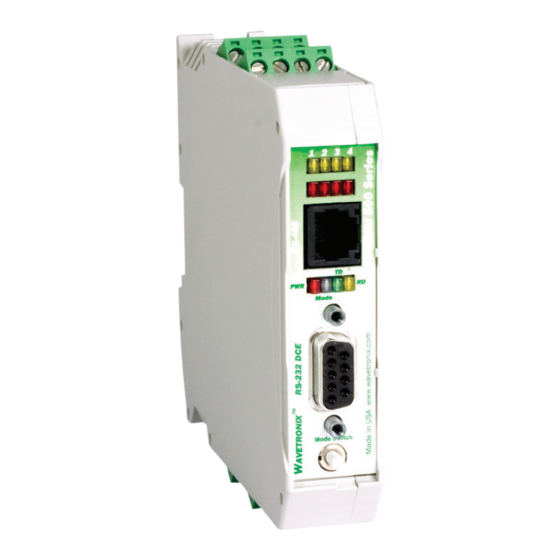
Table of Contents
Advertisement
Quick Links
Using a Click 510
0536
The Click 510 serves as a powerful, cabinet-level communication troubleshooting tool. It has the ability to emulate
a SmartSensor V and to perform data integrity and data latency tests.
Note. With the release of version 2.0, the Click 510 is now an application that runs on the Click 500 series
hardware platform. Some features of v2.0 operate differently than that of the v1.0 product, which had a custom
platform. The following documentation is specific to v2.0. If you have an earlier version of the Click 510, you will
need to refer to previous documentation. Contact Wavetronix Support for assistance.
Physical Features
The Click 510 physical features are used for easy installation and configuration.
RS-232
T-Bus
Connector
TOP
RS-485
Connector
Connector
FRONT
RS-485
Connector
LED Indicators
RS-232
Connector
Mode
Switch
Inputs
DIP Switches
Connector
Outputs
Connector
WX-501-0536 • 01.22
1 of 9
Advertisement
Table of Contents

Summary of Contents for Wavetronix Click 510
- Page 1 SmartSensor V and to perform data integrity and data latency tests. Note. With the release of version 2.0, the Click 510 is now an application that runs on the Click 500 series hardware platform. Some features of v2.0 operate differently than that of the v1.0 product, which had a custom platform.
-
Page 2: Communication Ports
Click modules. While it can be used to convert RS-485 communications to RS-232, this is not its normal usage. Instead on the Click 510 this port is normally used to upgrade the Click 510 program or reprogram the unit for custom applications. -
Page 3: Installation
Emulation mode. In this application, you can check the connection to and functionality of the contact closure device. The Click 510 will send out data in the form of test traffic data; whether or not this data is received can be observed by monitoring the contact closure device. -
Page 4: Operating Modes
Click 510 to the computer using a program such as HyperTerminal. Use HyperTerminal to send data and monitor the Click 510 to see if it is received, or use the Click 510 to send data and monitor the response on HyperTerminal. - Page 5 ■ Note. If you would like to have the Click 510 emulate a sensor, but not actively transmit any data, use submenu 1 to select the Switch option. As long as you don’t press the push button the sensor will be passive. This will allow you to use the Click 510 in conjunction with a Click 100, 172, or 174.
-
Page 6: Test Pattern
Test Pattern submenu 2 allows you to select which data packet will be sent to the Click 510 or computer. The submenu 2 selections are displayed on the device by the red LEDs. Data packets come in two forms; LED commands and ASCII text strings. - Page 7 HyperTerminal. The following commands can be sent (you can also see this menu by typing “m” in HyperTerminal): 1 . . . 8 – Lights up the corresponding LED on the Click 510. For example, typing a 5 causes the fifth LED to illu- ■...
-
Page 8: Latency Test
The discovery process attempts all the baud rates listed in the figure above. SmartSensor V autobaud discovery requests are sent at each baud rate. If a response to a request is received, the Click 510 baud rate will be set to match the SmartSensor baud rate. - Page 9 © 2022 Wavetronix LLC. All rights reserved. Protected in the US by patents viewable at www.wavetronix.com/en/legal. Protected by Canadian Patent Nos. 2461411; 2434756; 2512689; and European Patent Nos. 1435036; 1438702; 1611458. Other US and international patents pending. Wavetronix, SmartSensor, Click, Command and all associated logos are trademarks of Wavetronix LLC. All other product or brand names as they appear are trademarks or registered trademarks of their respective holders.




Need help?
Do you have a question about the Click 510 and is the answer not in the manual?
Questions and answers